-
Countries
-
Data and Analysis
-
Special Focus
-
Crisis Responses
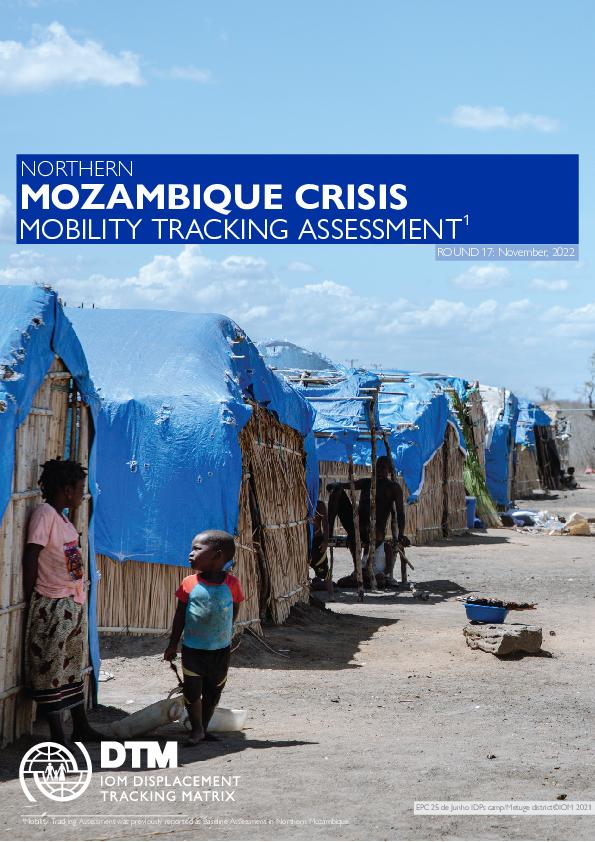
Contact
DTM Mozambique, DTMMozambique@iom.int
Language
English
Location
Mozambique
Period Covered
Oct 16 2022
Nov 16 2022
Activity
- Mobility Tracking
This summary presents findings of the 17th round of Mobility Tracking Assessments (previously known as Baseline Assessments) conducted across Northern Mozambique through key-informant assessments at district and location-level in November 2022. Mobility Tracking assessments estimate the presence of Internally Displaced Persons (IDPs) and returnees across Northern Mozambique in displacement sites and host communities. IOM DTM mapped a total of 1,028,743 IDPs and 352,437 returnees in 238 locations across Northern Mozambique as of November 2022.
Despite the observed presence of returns in newly accessible locations, there remains a significant number of new displacements between June to November 2022 triggered by sporadic attacks in Ancuabe, Balama, Chiure, Erati Meluco, Namuno and Nangade. For the purposes of IOM DTM data collection, the returnee population category is restricted to individuals who have returned to the locations/bairros of their habitual residence, based on a free decision. In Mozambique, displaced persons having returned to districts of origin without having reached their locality of origin are still displaced and as such not counted in the returnee category. The districts of Mocimboa da Praia, Nangade, Quissanga and Macomia continue to host persons in displacement settings who have yet to return to their respective locality of habitual residence (and as such not counted in returnee category).
Contact
DTM Mozambique, DTMMozambique@iom.int
Location
Mozambique
Activity
- Mobility Tracking
- Site Assessment
Period Covered
Oct 17 2022 -Nov 15 2022
A site assessment is a sub-component of mobility tracking. It aims to collect data on population presence, living conditions and needs in a particular displacement site or community.
Population Groups
Survey Methodology
Unit of Analysis Or Observation
Type of Survey or Assessment
Keywords
Geographical Scope
Administrative boundaries with available data
The current dataset covers the following administrative boundaries
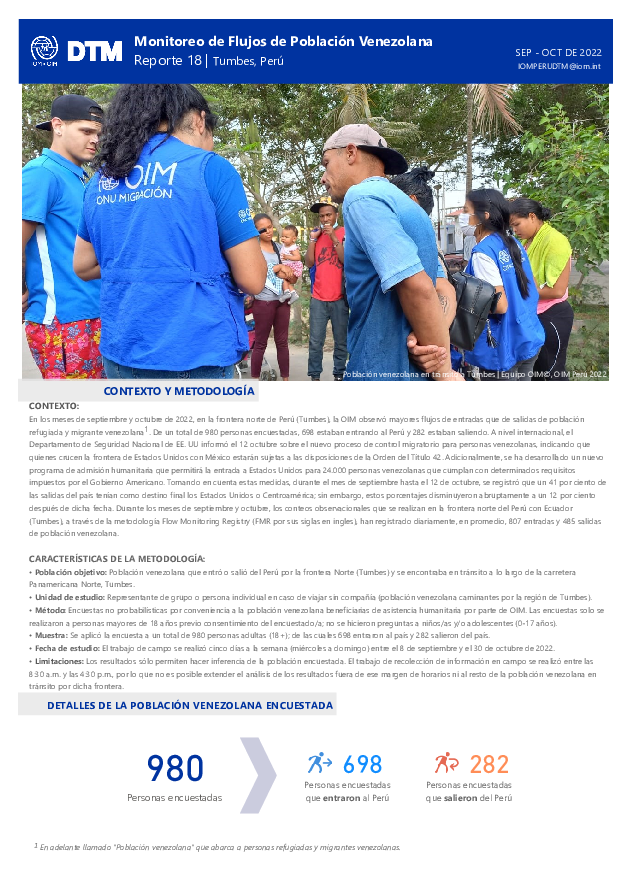
Contact
DTM Peru, IOMDTMPeru@iom.int
Language
Spanish
Location
Peru
Period Covered
Sep 01 2022
Oct 31 2022
Activity
- Flow Monitoring
En los meses de septiembre y octubre de 2022, en la frontera norte de Perú (Tumbes), la OIM observó mayores flujos de entradas que de salidas de población refugiada y migrante venezolana . De un total de 980 personas encuestadas, 698 estaban entrando al Perú y 282 estaban saliendo. A nivel internacional, el Departamento de Seguridad Nacional de EE. UU informó el 12 octubre sobre el nuevo proceso de control migratorio para personas venezolanas, indicando que quienes crucen la frontera de Estados Unidos con México estarán sujetas a las disposiciones de la Orden del Título 42. Adicionalmente, se ha desarrollado un nuevo programa de admisión humanitaria que permitirá la entrada a Estados Unidos para 24.000 personas venezolanas que cumplan con determinados requisitos impuestos por el Gobierno Americano. Tomando en cuenta estas medidas, durante el mes de septiembre hasta el 12 de octubre, se registró que un 41 por ciento de las salidas del país tenían como destino final los Estados Unidos o Centroamérica; sin embargo, estos porcentajes disminuyeron abruptamente a un 12 por ciento después de dicha fecha. Durante los meses de septiembre y octubre, los conteos observacionales que se realizan en la frontera norte del Perú con Ecuador (Tumbes), a través de la metodología Flow Monitoring Registry (FMR por sus siglas en ingles), han registrado diariamente, en promedio, 807 entradas y 485 salidas de población venezolana.
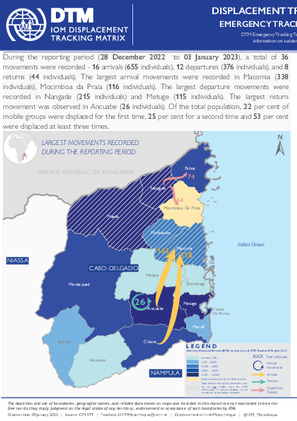
Contact
DTMMozambique@iom.int
Language
English
Location
Mozambique
Period Covered
Dec 28 2022
Jan 03 2023
Activity
- Mobility Tracking
- Event Tracking
During the reporting period (28 December 2022 to 03 January 2023), a total of 36 movements were recorded - 16 arrivals (655 individuals), 12 departures (376 individuals), and 8 returns (44 individuals). The largest arrival movements were recorded in Macomia (338 individuals), Mocimboa da Praia (116 individuals). The largest departure movements were recorded in Nangade (215 individuals) and Metuge (115 individuals). The largest return movement was observed in Ancuabe (26 individuals). Of the total population, 22 per cent of mobile groups were displaced for the first time, 25 per cent for a second time and 53 per cent were displaced at least three times.

Contact
DTMMozambique@iom.int
Language
English
Location
Mozambique
Period Covered
Dec 01 2022
Dec 31 2022
Activity
- Mobility Tracking
- Event Tracking
During the reporting period (1 to 31 December 2022), a total of 37 movements were recorded - 18 arrivals (170 individuals), 19 departures (168 individuals). The largest arrival movements were recorded in Cidade de Nampula (159 individuals). The largest departure movements were recorded in Cidade de Nampula (120 individuals). Of the total population, 76 per cent of mobile groups were displaced for the first time and 24 per cent for a second time.
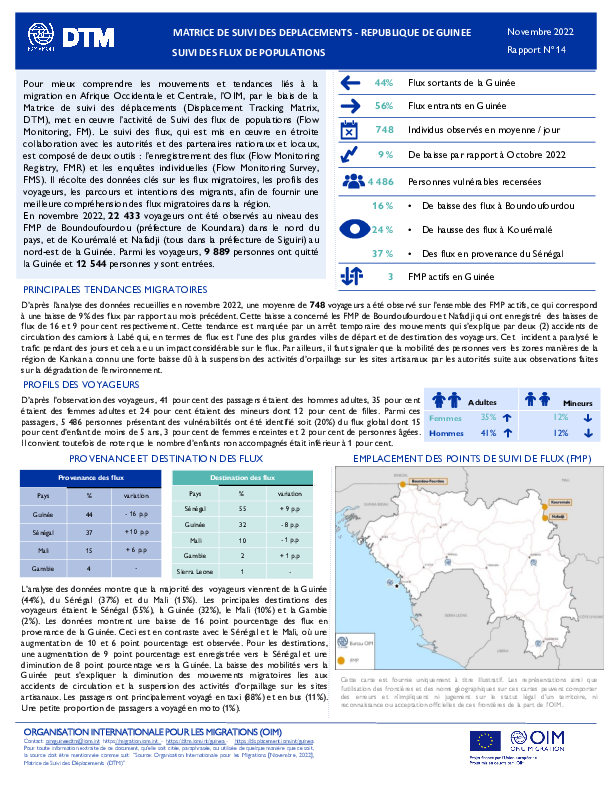
Contact
Djiguiba Camara, RODakarEPCTeam@iom.int
Language
French
Location
Guinea
Period Covered
Nov 01 2022
Nov 30 2022
Activity
- Flow Monitoring
Pour mieux comprendre les mouvements et tendances liés à la migration en Afrique Occidentale et Centrale, l’OIM, par le biais de la Matrice de suivi des déplacements (Displacement Tracking Matrix, DTM), met en œuvre l’activité de Suivi des flux de populations (Flow Monitoring, FM). Le suivi des flux, qui est mis en œuvre en étroite collaboration avec les autorités et des partenaires nationaux et locaux, est composé de deux outils : l’enregistrement des flux (Flow Monitoring Registry, FMR) et les enquêtes individuelles (Flow Monitoring Survey, FMS). Il récolte des données clés sur les flux migratoires, les profils des voyageurs, les parcours et intentions des migrants, afin de fournir une meilleure compréhension des flux migratoires dans la région.
En novembre 2022, 22 433 voyageurs ont été observés au niveau des FMP de Boundoufourdou (préfecture de Koundara) dans le nord du pays, et de Kourémalé et Nafadji (tous dans la préfecture de Siguiri) au nord-est de la Guinée. Parmi les voyageurs, 9 889 personnes ont quitté la Guinée et 12 544 personnes y sont entrées.

Contact
DTM Cameroon, DTMCameroun@iom.int
Language
French
Location
Cameroon
Period Covered
Jan 02 2023
Jan 04 2023
Activity
- Mobility Tracking
- Event Tracking
Le suivi des situations d’urgence (en anglais, Emergency Tracking Tool, ETT) est une des composantes de la Matrice de suivi des déplacements (DTM) déployée par l’Organisation Internationale pour les Migrations (OIM). Il a pour objectif de rassembler des informations sur les mouvements significatifs et soudains de populations ainsi que sur des urgences sécuritaires et climatiques. Les données ont été collectées par observation directe et par des entretiens téléphoniques, auprès de 09 informateurs clés, principalement les autorités locales, les organisations non gouvernementales (ONGs), les organisations de la société civile (OSCs) et les représentants des populations dans les lieux affectés. Ce tableau de bord présente des informations sur des mouvements progressifs de personnes depuis la localité de Gakara située dans l’arrondissement de Kolofata (département du Mayo- Sava) vers la localité de Kerawa centre dans le même arrondissement, survenus depuis le 31 décembre 2022 jusqu’au 04 janvier 2023.
Contact
DTM Burundi, DTMBurundi@iom.int
Location
Burundi
Activity
- Mobility Tracking
- Event Tracking
Period Covered
Dec 18 2022 -Dec 24 2022
Activated on an ad hoc basis, the DTM Emergency Tracking provides early field reports at the beginning of a complex crisis, allowing IOM to gather, consolidate and disseminate baseline information on displacement and return figures at the onset of a newly emerging crisis. The DTM Emergency Tracking relies heavily on information provided by RARTs or partners within the humanitarian community about an unfolding situation. The Emergency Tracking gathers data through IOM Burundi’s extended network of key informants, who provide basic information on the new displacement, be it of IDPs or returnees, or both, including numbers, location and shelter types. While IOM DTM strives to provide best estimates, the Emergency Tracking aims to be a quick monitoring tool with real-time data turnover ranging from 24 to 72 hours following its activation.
Population Groups
Survey Methodology
Unit of Analysis Or Observation
Type of Survey or Assessment
Keywords
Geographical Scope
Administrative boundaries with available data
The current dataset covers the following administrative boundaries
Contact
DTM Burundi, DTMBurundi@iom.int
Location
Burundi
Activity
- Mobility Tracking
- Event Tracking
Period Covered
Dec 25 2022 -Dec 31 2022
Activated on an ad hoc basis, the DTM Emergency Tracking provides early field reports at the beginning of a complex crisis, allowing IOM to gather, consolidate and disseminate baseline information on displacement and return figures at the onset of a newly emerging crisis. The DTM Emergency Tracking relies heavily on information provided by RARTs or partners within the humanitarian community about an unfolding situation. The Emergency Tracking gathers data through IOM Burundi’s extended network of key informants, who provide basic information on the new displacement, be it of IDPs or returnees, or both, including numbers, location and shelter types. While IOM DTM strives to provide best estimates, the Emergency Tracking aims to be a quick monitoring tool with real-time data turnover ranging from 24 to 72 hours following its activation.
Population Groups
Survey Methodology
Unit of Analysis Or Observation
Type of Survey or Assessment
Keywords
Geographical Scope
Administrative boundaries with available data
The current dataset covers the following administrative boundaries
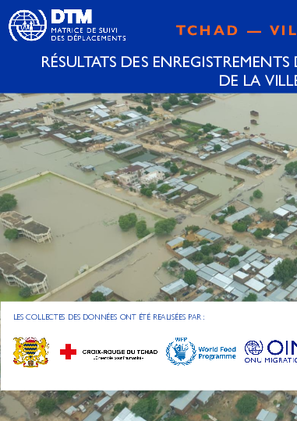
Contact
DTM Chad, dtmtchad@iom.int
Language
French
Location
Chad
Period Covered
Oct 25 2022
Oct 27 2022
Activity
- Survey
- Mobility Tracking
- Baseline Assessment
- Village Assessment
Au Tchad, chaque année lors des saisons pluvieuses, des inondations sont observées suite aux fortes pluies. Cependant, l’année 2022 est caractérisée à la fois par des grosses quantités de pluies mais aussi par des montées des fleuves (chari et Logone) durant le mois d’octobre causant des inondations presque dans tout le pays. Afin de collecter des données approfondies sur les ménages affectés par les inondations fluviales, un entretien avec tous les chefs de ménages déplacés ou leurs représentants dans les 7 sites ciblés a été réalisé.
Les résultats de l’enregistrement indiquent que 14 144 ménages, constitués de 71 149 individus, ont été déplacés dans les sites de la ville de N’djamena suite aux inondations fluviales. Avec 9 332 ménages (48 080 individus), le neuvième arrondissement a été celui hébergeant le plus grand nombre des personnes déplacées (68%). Puis Koundoul, avec 2 516 ménages (12 782 individus déplacés; soit 18%) et le premier arrondissement avec 2 296 ménages (10 287 individus déplacés, soit 14%).